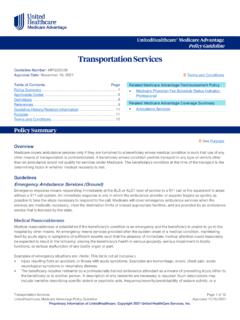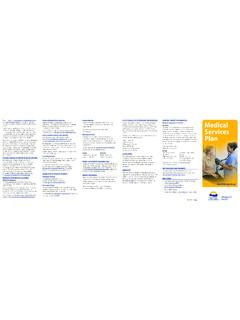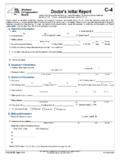Transcription of Repetitive, Scheduled Non-Emergent Ambulance Transport ...
1 1 repetitive , Scheduled Non-Emergent Ambulance Transport Prior Authorization Model Operational Guide UPDATED 0 5 / 0 5 /2022 2 Table of Contents 2 - repetitive , Scheduled Non-Emergent Ambulance Transport Medicare Benefit .. 4 3 - Model Overview .. 6 - Model 6 - Model Start Dates by State .. 6 4 - Healthcare Common Procedure Coding System (HCPCS) Codes .. 8 5 - Number of Trips .. 9 - Special Consideration for Beneficiaries with a Chronic medical Condition .. 9 6 - Submitting a Request .. 10 - Submission Timeframes .. 11 - Submission 11 - MAC Contact Information .. 11 - Prior Authorization Request Review .. 13 7 - Provisional Affirmative Decisions .. 15 - Ambulance Supplier s Actions .. 15 8 - Non-Affirmative Decisions .. 16 - Ambulance Supplier s Action .. 16 9 - Resubmitting a Prior Authorization Request.
2 17 10 - Secondary Insurance .. 18 - Medicare is the Primary Insurance .. 18 - Medicare is the Secondary Insurance .. 18 11 - Claim Submission with Prior Authorization .. 19 - Affirmed Prior Authorization Decision .. 19 - Non-Affirmed Prior Authorization Decision .. 19 - Mileage Code Billing .. 19 12 - Claim Submission without Prior Authorization .. 20 - The Prepayment Review Process .. 20 13 - Claim Appeals .. 21 Appendix A - Prior Authorization Request Process .. 22 Appendix B - Claim Line Process with Prior Authorization .. 23 Appendix C - Claim Line Process without Prior Authorization .. 24 3 1 - Purpose The repetitive , Scheduled Non-Emergent Ambulance Transport Prior Authorization Model is authorized by section 1834(l)(16) of the Social Security Act (the Act), as added by section 515(b) of Medicare Access and CHIP Reauthorization Act of 2015 (Pub.)
3 L. 114-10). It establishes a process through which a request for provisional affirmation of coverage is submitted for review before the service is furnished to a beneficiary and before the claim is submitted for payment. Prior authorization helps to make sure that applicable coverage, payment and coding rules are met before services are rendered. The purpose of this Operational Guide is to interpret and clarify the prior authorization process for Medicare participating Ambulance suppliers when rendering repetitive , Scheduled Non-Emergent Ambulance transports to Medicare Fee-for-Service beneficiaries. These guidelines aim to provide operational guidance and do not alter the requirements set forth in Title 42 of the Code of Federal Regulations (CFR) (e) and in applicable Local Coverage Determinations and Local Coverage Articles found at 4 2 - repetitive , Scheduled Non-Emergent Ambulance Transport Medicare Benefit For any service to be covered by Medicare it must: A.
4 Be eligible for a defined Medicare benefit category, B. Be reasonable and necessary for the diagnosis or treatment of illness or injury or to improve the functioning of a malformed body member, and C. Meet all other applicable Medicare statutory and regulatory requirements. The medical necessity requirements for Medicare coverage of Ambulance services are set forth in 42 CFR (e). Medicare covers Ambulance services including air Ambulance (fixed wing and rotary wing), when: A. Furnished to a beneficiary whose medical condition is such that other means of transportation are contraindicated. B. The beneficiary s condition must require both the Ambulance transportation itself and the level of service provided in order for the billed service to be considered medically necessary. In addition to the medical necessity requirements, the service must meet all other Medicare coverage and payment requirements, including requirements relating to the origin and destination of the transportation, vehicle and staff, and billing and reporting.
5 Additional information about Medicare coverage of Ambulance services can be found in 42 CFR , , and in the publication 100-02 Medicare Benefit Policy Manual, Chapter 10. Non-Emergent transportation by Ambulance is appropriate if either: A. The beneficiary is bed-confined and it is documented that the beneficiary s condition is such that other methods of transportation are contraindicated; or, B. The beneficiary s medical condition, regardless of bed confinement, is such that transportation by Ambulance is medically required. Thus, bed confinement is not the sole criterion in determining the medical necessity of Ambulance transportation. It is one factor that is considered in medical necessity For a beneficiary to be considered bed-confined, the following criteria must be met: 2 A. The beneficiary is unable to get up from bed without assistance.
6 B. The beneficiary is unable to ambulate. C. The beneficiary is unable to sit in a chair or wheelchair. A repetitive Ambulance service is defined as medically necessary Ambulance transportation that is furnished three or more times during a ten-day period; or at least once per week for at least 1 42 CFR (e)(1). 2 42 CFR (e)(1). 5 three repetitive Ambulance services are often needed by beneficiaries receiving dialysis or cancer treatment. Medicare may cover repetitive , Scheduled Non-Emergent transportation by Ambulance if A. The medical necessity requirements described above are met, and B. The Ambulance supplier, before furnishing the service to the beneficiary, obtains a written order from the beneficiary s attending physician certifying that the medical necessity requirements are met (see 42 CFR (e)(1) and (2)).
7 4 For more information on local coverage and documentation requirements, please refer to applicable Local Coverage Determinations and Articles found at the Medicare Coverage Database. 3 Program Memorandum Intermediaries/Carriers, Transmittal AB-03-106. 4 Per 42 CFR (e)(2), the physician s order must be dated no earlier than 60 days before the date the service is furnished. 6 3 - Model Overview The model establishes a prior authorization process for repetitive , Scheduled Non-Emergent Ambulance transports to reduce the utilization of services that do not comply with Medicare policy while maintaining or improving quality of care. Prior authorization does not create any new documentation requirements. It requires the same information that is already required to support Medicare payment.
8 Prior authorization is voluntary; however, if the Ambulance supplier elects to bypass prior authorization, applicable repetitive , Scheduled Non-Emergent Ambulance Transport claims will be subject to a prepayment medical record review. Claims for the first three round trips are permitted to be billed without prior authorization and without being subject to prepayment medical record review. - Model Inclusion The model applies to independent Ambulance suppliers that are not institutionally based providing Part B Medicare covered Ambulance services billed on a CMS-1500 Form and/or a HIPAA compliant ANSI X12N 837P electronic transaction. Ambulance suppliers under review by a Unified Program Integrity Contractor (UPIC) are not eligible to submit prior authorization requests. Hospital-based Ambulance providers owned and/or operated by a hospital, critical access hospital, skilled nursing facility, comprehensive outpatient rehabilitation facility, home health agency, or hospice program are not included and should not request prior authorization.
9 - Model Start Dates by State5 New Jersey, Pennsylvania, and South Carolina started on December 1, 2015 for transports occurring on or after December 15, 2014. Delaware, the District of Columbia, Maryland, North Carolina, Virginia, and West Virginia started on December 15, 2015 for transports occurring on or after January 1, 2016. Arkansas, Colorado, Louisiana, Mississippi, New Mexico, Oklahoma, and Texas (Jurisdiction H) started on November 17, 2021 for transports occurring on or after December 1, 2021. Alabama, American Samoa, California, Georgia, Guam, Hawaii, Nevada, Northern Mariana Islands, and Tennessee (Jurisdictions E and J) started on January 18, 2022 for transports occurring on or after February 1, 2022. Florida, Illinois, Iowa, Kansas, Minnesota, Missouri, Nebraska, Puerto Rico, Wisconsin, and Virgin Islands (Jurisdictions N, 5, and 6) started on March 18, 2022 for transports occurring on or after April 1, 2022.
10 Connecticut, Indiana, Maine, Massachusetts, Michigan, New Hampshire, New York, Rhode Island, and Vermont (Jurisdictions K and 8) will start on May 18, 2022 for transports occurring on or after June 1, 2022. 5 Location is based on where the Ambulance supplier is garaged. 7 Alaska, Arizona, Idaho, Kentucky, Montana, North Dakota, Ohio, Oregon, South Dakota, Utah, Washington, and Wyoming (Jurisdictions F and 15) will start no earlier than August 1, 2022. o Railroad Retirement Board beneficiaries nationwide will start no earlier than August 1, 2022. 8 4 - Healthcare Common Procedure Coding System (HCPCS) Codes The following Ambulance HCPCS codes are subject to prior authorization: A0426 - Ambulance service, Advanced Life Support (ALS), non-emergency Transport , Level 1 A0428 - Ambulance service, Basic Life Support (BLS), non-emergency Transport Prior authorization is not needed for the mileage code, A0425, as it is treated as an associated procedure.













